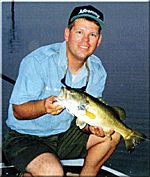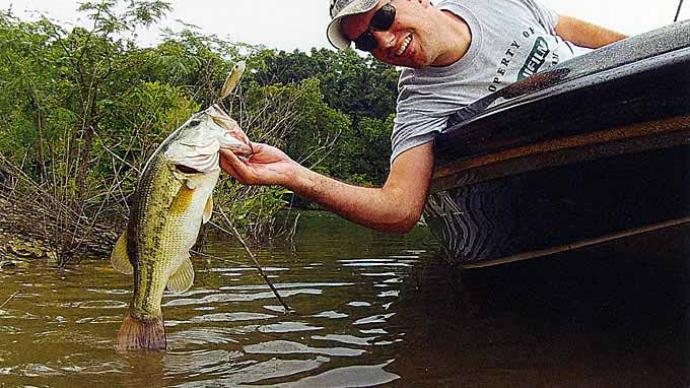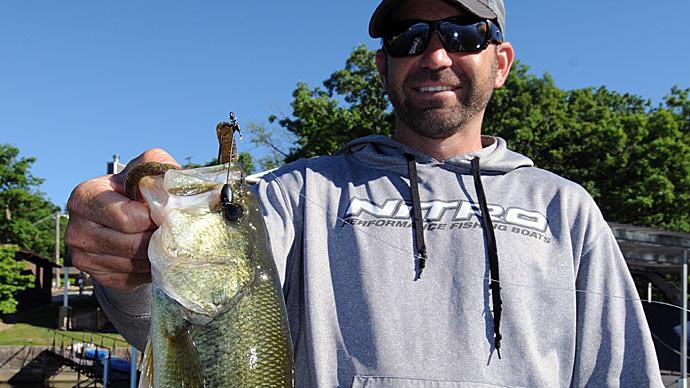
No matter your level of bass fishing, as a recreational angler or touring pro, you will have to make many decisions during a day or over a weekend of fishing. Some of the first decisions made will be to determine what section of the lake to fish, what baits are working the best, and what the hot colors are. There are also decisions to be made about what type of structure the fish are relating to. Are they holding on timber, grass, rocks, docks, etc.?
As a recreational fisherman, it is no big deal if you make a few wrong decisions because you can fish another day. On the other hand, the tournament fisherman's decisions can make the difference in taking a check and going home empty-handed. Too many wrong decisions can lead to being unable to be a touring pro for very long, if at all.
With all the decisions that anglers must make during a fishing day, lure size is sometimes overlooked. Most anglers, including tournament anglers, will go through the process of trying to figure out the lure color and will even match the appropriate line size. Still, many forget to match lure size to the current situation.
Lure size is a wide-open topic, and many times the size of the bait is relative to the fisherman fishing it. What one angler considers a small lure may not be considered small to another angler. Many anglers refer to some lures as "Bubba" baits or "sissy" baits. Are "Bubba" baits big and "sissy" baits small? Does a power bait have to be big and a finesse bait small?
I don't know the correct definition, but I consider small baits as downsizing in that particular bait category.
There are several reasons to fish a small bait; this can play a big part in the decision process that anglers must make during their time on the water. Many factors, such as water clarity, angling pressure, available forage, inactive fish, weather conditions, and the size of bass you are targeting, are variables that we face. Small baits can play a vital role in making a successful day on the water.
I would like to go through some of these factors and give insight into how I handle these situations with some of my favorite small baits.
Water Clarity
Lure size is something to take into consideration when fishing clear water. In clear water, the more bait you show, the easier it is for the bass to identify it and change its mind about hitting it. Small baits are almost mandatory when fishing in clear-water conditions. Many anglers will match the line size and bait color when fishing clear water but do not give bait size proper consideration.
Most of us face clear-water situations when bed fishing during the spring. At some lakes we fish, we have clear water most of the year. Bass will sometimes ignore a big worm or lizard, but a small bait with a subtle action can trigger a bite. One small bait that is a mainstay for my clear water fishing is a Hibdon's series tube by Gambler.
I guide on Gibbons Creek Reservoir (Texas), so I do not have to worry about the water being too clear. However, fishing tournament trails, I will sooner or later face a clear-water situation.
There are times when water clarity and light penetration change during a day of fishing. This is where the angler must adjust to the change. Keep in mind the opposite situation can happen. Runoff from a steady rain or an increase in the wind can muddy the water, and downsizing or fishing a smaller bait would not be the best. But a bright, sunny sky following a cold front can increase water visibility. When fishing either extreme, bait size can mean the difference between catching fish and blanking.
Angling Pressure
In the spring, for example, there are a lot of anglers on the lake, and my home lake is no exception. Gibbons Creek is a small lake compared to Rayburn, Toledo Bend, Livingston, and many others. Everyone is forced in many ways to fish in the same areas, especially during the spawn when the bass are on the bank. If everyone is throwing the same bait and many times the same size as well, this is an excellent time to consider changing bait size. You want to give the bass something a little different to look at.
When fishing "used water," like fishing behind another boat, fishing smaller baits can produce more bites or pick off missed fish. For example, if everyone is throwing a 6-inch lizard, I may switch to a 4-inch lizard. Another example would be if the boat in front of me is flipping a jig and craw-worm, then I would change to flipping a Texas-Rigged tube or French fry.
The bass that first bait passed in front of has now seen a big, bulky jig. Changing to small plastic can catch that fish after other boats have worked in the same area.
Matching the Available Forage
The baitfish will be different sizes depending on the lake and the time of year. Matching the bait to the forage size is generally the best method to produce more consistent action. There are many ways to determine the size of the shad in the area. Pay attention. Look for clusters of shad swimming around. Shad will move up near rocks and rip-rap in the late spring to spawn. I usually try to match the blade size on my spinnerbait to those shad.
If the baitfish you see are small, throwing larger baits is going against what bass are likely to be feeding on. For example, the shad in the fall at Gibbons Creek is really close to the size of a 1/4-ounce Rat-L-Trap. A 1/4-ounce Rat-L-Trap is one of my favorite small baits and will out-fish a 1/2-ounce Trap 4 to 1 during this time of year.
Facing Inactive Bass or Unfavorable Weather Conditions
If you have spent any amount of time on the water, you have faced conditions where the bass were inactive. Bass could be in a non-aggressive mood or just not hungry. Small worms in a 4- or 5-inch size can be enough to create a little snack and produce a bite.
Many times the bass are inactive because of weather conditions. There is nothing like fishing on the backside of a severe cold front. When bass lock down in a bush or brush pile, downsizing to small baits such as a 3/16-ounce jig, 4-inch lizard, or tube can help produce a few bites. The slow fall and subtle approach can be enough to trigger those few precious bites.
Size of Bass You Are Targeting
I have fished several lakes where the general bass populations are small, and a 14-inch bass is hard to come by. However, many times a limit of keeper bass in a tournament will win you a check or a least keep you in the points race.
This is an excellent time to fish smaller baits. If you are fishing a small farm pond with an abundance of undersized bass, then small baits are a must. A 4-inch Texas-rigged worm will do the trick, along with a 1/4-ounce buzzbait or a 3- or 4-inch jerkbait.
Operating a guide service, I prefer my customers to fish with small baits, especially when throwing a Carolina rig in the summer. Small worms will produce more bites and still give the opportunity to catch a big fish. My best was a 10-1/2-pound beauty from Lake Conroe on a black and blue 4-inch ringworm one spring.
Small baits are great for novice anglers and kids because you create more opportunities for a bite, resulting in more activity.
We have gone through some conditions where small baits will help you when facing certain situations. Small baits are a big part of my fishing arsenal and can be fished not only in the spring but also year-round.
At other times of the year, some of my other favorite small baits are a Tiny Torpedo or a Zara Puppy, fished around shallow vegetation during post-spawn and summer. Other summer baits that I rely on when fishing the deep structure is a Carolina-rigged weenie worm or ringworm. Another bait I consider small is a Little George, which is good for schooling bass but can be used when bass are inactive. And I have caught a ton of fish on a 1/4-ounce Rat-L-Trap in the fall.
Big lures will also catch little fish, but you will catch more fish with smaller baits, and there are times during tough conditions when small baits are enough to produce a few extra bites or even that really big one.
On your next fishing trip, remember the little guys because they have their place and time in your overall fishing success. Until next time, good luck and good fishing.




